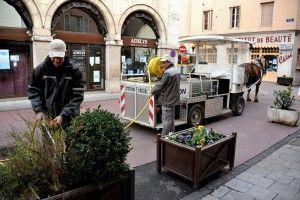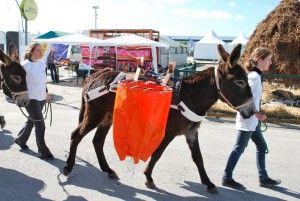The Working Horse in Municipalities
What is this?
The concept of the “municipal horse” emerged a few years ago, with strong connotations of public function. The wording refers to horses that are used by municipalities to carry out public service functions within their territory, including transporting passengers, picking up waste, the upkeep of green spaces or natural spaces, and preventive/security actions. It consists of an alternative energy source that subscribes to a policy of sustainable development within municipalities (Duriez,Foquet, 2011, study for the French Ministry of Agriculture).
Different Uses for Working Horses in Municipalities
Municipal horses can bring about a suitable solution to a variety of problems that arise in municipalities in terms of providing public services:
- Transporting people;
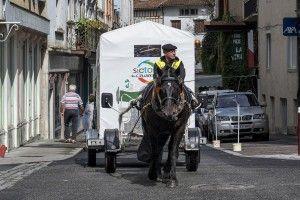
© ANR – Castillonnais
- Collecting waste: glass, paper, cardboard, household waste;
- The upkeep of green spaces or streets: sweeping, watering, gathering up dead leaves, mowing grass etc.
- Security work: mounted patrols, eco guards;
- The upkeep of natural spaces: cleaning of waterways, river banks, beaches, soft pathways, communal woods and forests, late mowing etc.
Municipal horses can be managed either by the municipalities themselves owning them directly, or by making use of a service provider. In either case, it is necessary to optimize the logistics aspects (the distance between worksites and boarding facilities, daily upkeep and care of the horse, including at night, at weekends and during holidays). The work done by municipal horses can be seasonal, year-long, or occasional depending on management methods and needs.
The Benefits of Working Horses in Municipalities
The Environmental Aspect
Horses themselves present numerous environmental benefits. They are a means of transportation that uses renewable energy since their use does not lead to the extinction of the initial resource, with the energy being replenished faster than it is used up (observatoires Equiressources, 2011).
A study conducted by Equiterra, the Picardy region and ADEME (The French Environment and Energy Management Agency) between October 2007 and June 2009, and by CIVAM (Centres d’Initiatives pour Valoriser l’Agriculture et le Milieu rural/action centres to enhance agriculture and the rural environment), entitled “A Guide For the use of Horses by Municipalities in the Drôme” showed that the carbon footprint of a horse is lower than that of a lorry (Construction & Public Works No.7 type) for the same work over a set time. The municipalities thus see a saving in the use of polluting fossil fuels within a framework in which the horse turns out to be better suited than a motorized vehicle for slow-moving trips with frequent stops (which use up a lot of fuel).
Collection using horse-drawn vehicles can also help to reduce waste and improve sorting. In fact, according to the company Hippo-Ecolo (Hippo-Ecolo, 2013), the horse is an ambassador for sorting which leads to a 15% improvement in performance for the collection of selectively sorted goods, and an overall increase in sorted waste volume.
To reduce the costs associated with this work, it is vital to promote the reduction in waste at the source. The message that is communicating through the use of horses makes the inhabitants more aware of the action of sorting as well as how the waste is collected, and residents also tend to come out and chat with waste collectors as they go by.
- © JL Dugast – Arrosage jardinières de fleurs
- © Collection SFET – Collecte des déchets
The Economic Aspect
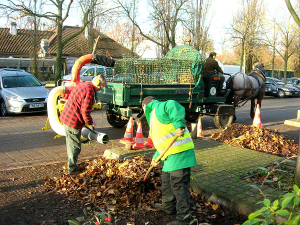
© IFCE – Ramassage feuilles mortes
In addition to the environmental advantages brought by horses in terms of sustainable development, there is also an economic advantage. Investing in a horse and horse-drawn vehicle is in principle cheaper than the investment needed for a motorized vehicle. According to the Institut Français du Cheval et de l’Equitation (French Institute of the Horse and Horsemanship), the average investment in a horse and horse-drawn vehicle is estimated at €9,400. In contrast, the average price for a similar vehicle would be €22,000 (€13,000 for a traditional vehicle).
Calculating the cost of putting in place municipal horses can vary greatly depending on the projects being considered by the municipality, and must be studied case by case, with a preliminary study. Operating costs must also be taken into consideration.
The use of horses in an urban environment offers an opportunity to maintain and develop a network of economic participants (manufacture of equipment, farriering, breeding, coachmen, social workers, trainers etc.)
The Social Aspect
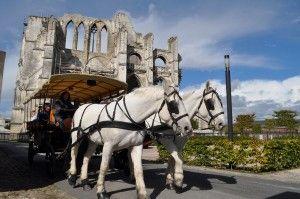
© IFCE – Boulonnais – Transport de personnes
Horses bring life back into urban environments. They encourage conviviality and communication via contact with the animals. By improving human relations, horses are at the root of social harmony.
Horses bring about contact and encourage communication which makes it easier to get messages across.
Through horses, there is an upgrading in the work of the people who are responsible for waste collection, with the horses restoring the bond between inhabitants and workers.
On the preventive/security side, the horse’s size encourages respect and brings with it a natural authority.
Some Figures
| Horse-Drawn Worksite | Potential Carbon Footprint Gain Compared to a Motorised Vehicle |
| Waste Collection | 35% |
| Mowing | 40% |
| People Transport | 60% |
| Upkeep of Green Spaces | 30% |
(Source : Equittera 2009 – comparisons made on a given worksite without taking into account getting there and back)
Colloques équi-meeting cheval territorial : retrouvez les vidéos des interventions dans la médiathèque ———————————————————————————————————————————————————————– Brest 2016 : http://www2.cheval-breton.fr/fr/actualites/autres-actualites/brest-pari-reussi,33015.html
